Alaska Documents
Quitclaim Deed
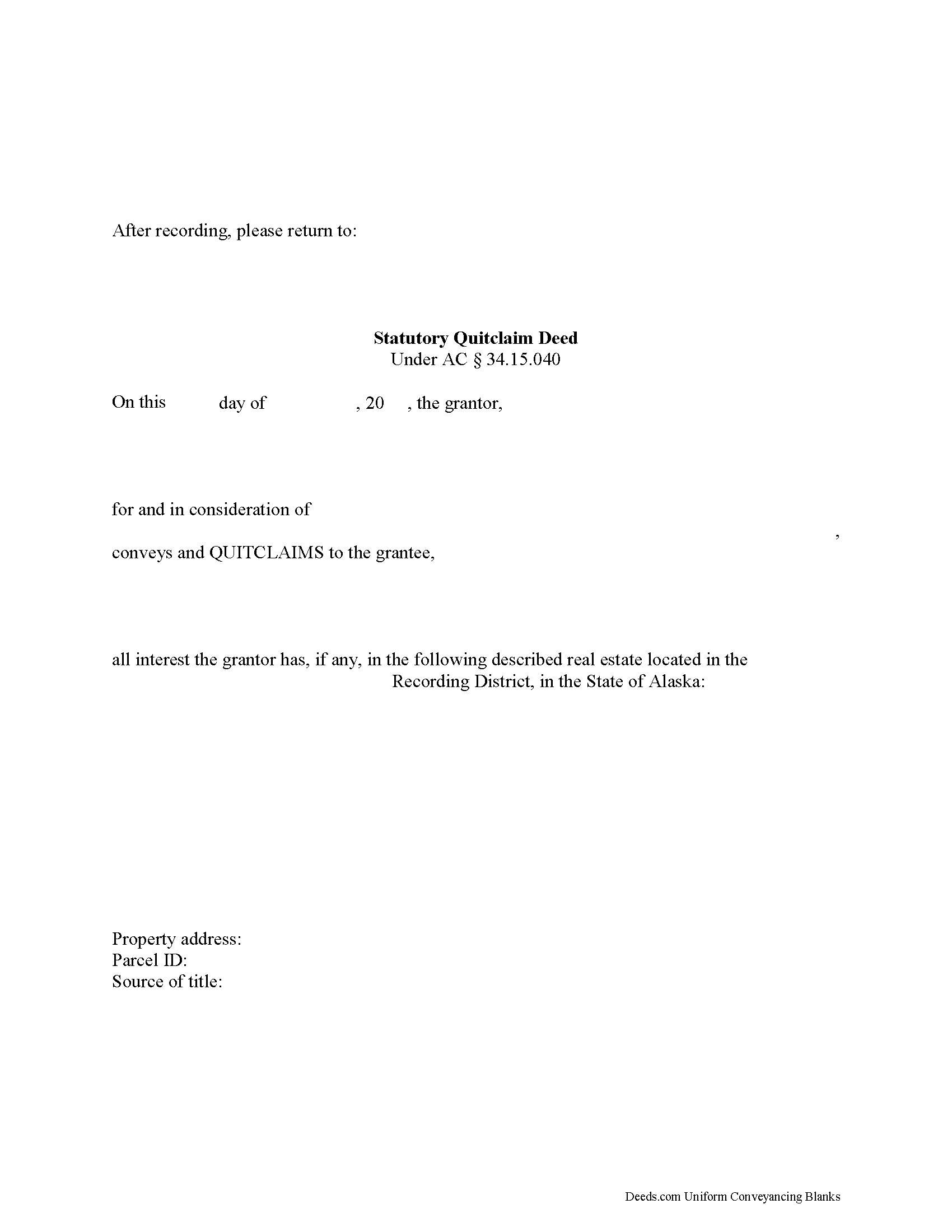
Valid quitclaim deeds in Alaska must meet certain statutory requirements.
Content:
To convey real property, the grantor must be of legal age or appoint an agent to act on his or her behalf. Beyond that, a quitclaim deed must contain original signatures of the grantor or authorized agent; a title that accurately reflects the overall intent of the document; a book and page reference or serial number reference of the prior recorded deed; the name and address of the individual to whom the document should be returned after recording; the names and mailing addresses of both the grantor and the grantee; the recording district in which it is to be recorded; a complete legal description of the property; the consideration paid (typically money); and a signed and dated acknowledgement by a notary or other official authorized to administer oaths and certify signatures. (See Alaska Stat. 34.15.010, et al)
If the property conveyed by the quit claim deed is identified as the grantor's homestead, the grantor's spouse, if any, must also sign the quit claim deed. This action does not grant the spouse any rights to the property if none existed before.
Recording:
The best way for the gra... More Information about the Alaska Quitclaim Deed
Gift Deed
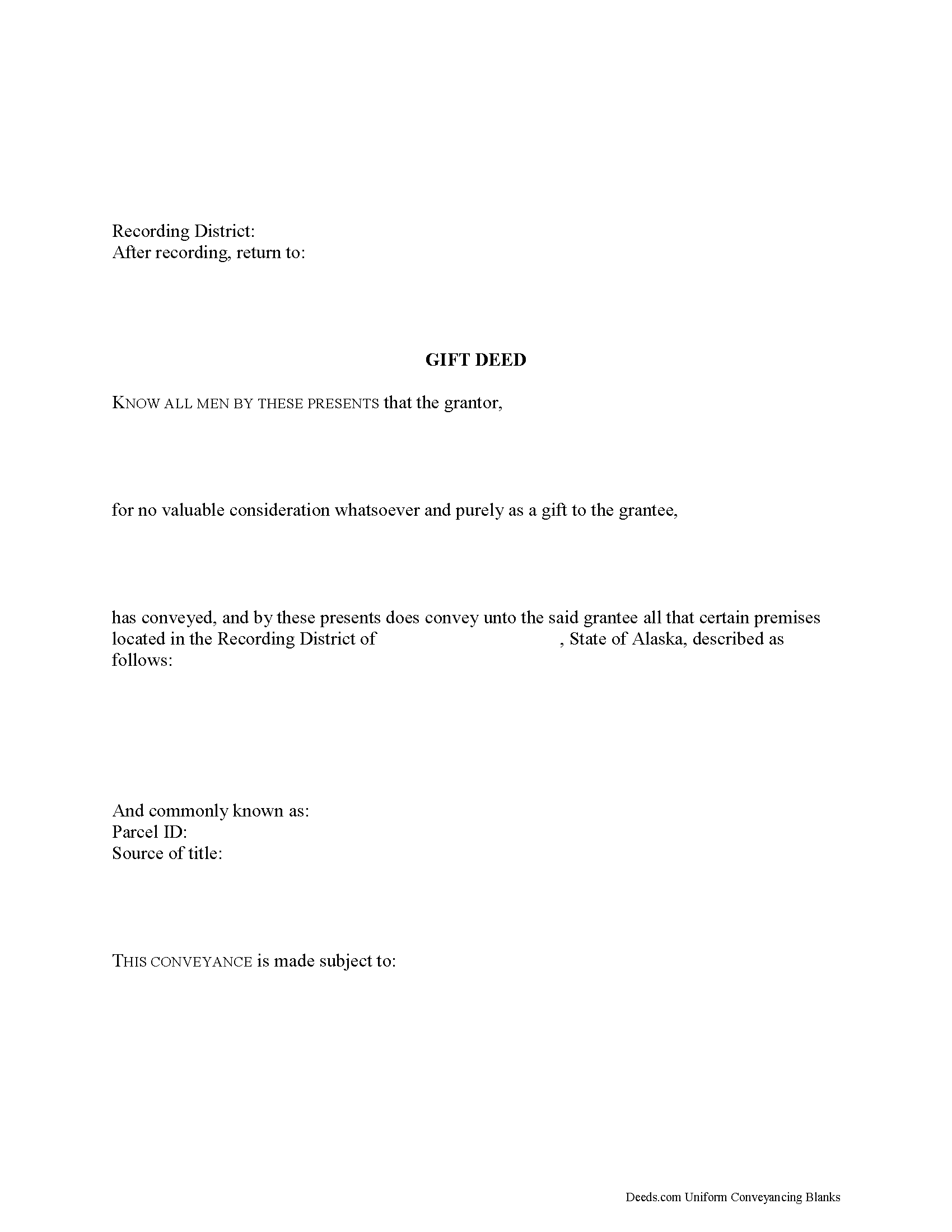
Gifts of Real Property in Alaska
Gift deeds convey title to real property from one party (the grantor or donor) to another (the grantee or donee) with no exchange of consideration, monetary or otherwise. Often used to transfer property between family members or to gift property as a charitable act or donation, these conveyances occur during the grantor's lifetime. It is important that a gift deed contain language that explicitly states that no consideration is expected or required. Ambiguous language, or references to any type of consideration, can make the gift deed contestable in court.
In Alaska, no covenants are implied in a conveyance of real property, even if the conveyance contains special covenants (AS 34-15-080). Any guarantees must meet statutory language as prescribed by AS 35-15-030.
A lawful gift deed includes the grantor's full name and marital status, as well as the grantee's full name, marital status, vesting, and mailing address. Vesting describes how the grantee holds title to the property. Generally, real property is owned in either sole ownership or in co-ownership. For Alaska residential property, the primary methods for holding title in co-ownership a... More Information about the Alaska Gift Deed
Warranty Deed
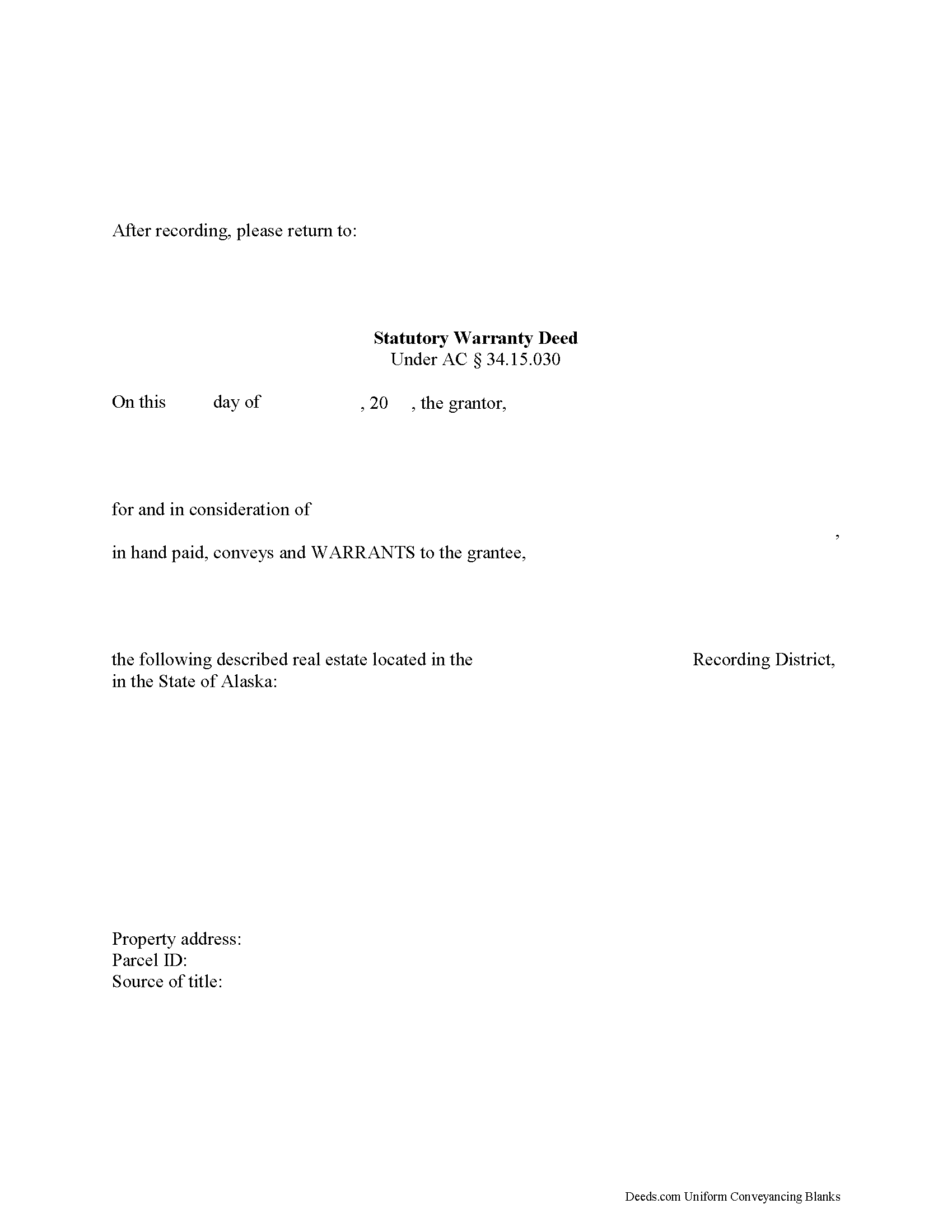
A conveyance of land in this state can be made by deed, signed and sealed by the grantor, and acknowledged or proved, and then recorded as provided by law.
The form for a warranty deed appears in 34.15.030 of the Alaska Revised Code and is written without express covenants. A deed of this type, when duly executed, is considered a conveyance in fee simple to the grantee and the grantee's heirs and assigns, with the following covenants from the grantor: (1) that at the time the warranty deed was made, the grantor was lawfully seized of an indefeasible estate in fee simple to the premises described, and has the right and power to convey the premises, (2) that the premises were free from encumbrances at the time the deed was made and delivered, and (3) that the grantor warrants the quiet and peaceable possession of the premises, and will defend the title to the premises against all persons claiming the premises (34.15.030).
After-acquired title or interest will pass by operation of law to the grantee or the grantee's successors in a warranty deed executed in Alaska (34.15.07).
An Alaska warranty deed should be acknowledged before a person authorized to take acknowledgement... More Information about the Alaska Warranty Deed
Special Warranty Deed
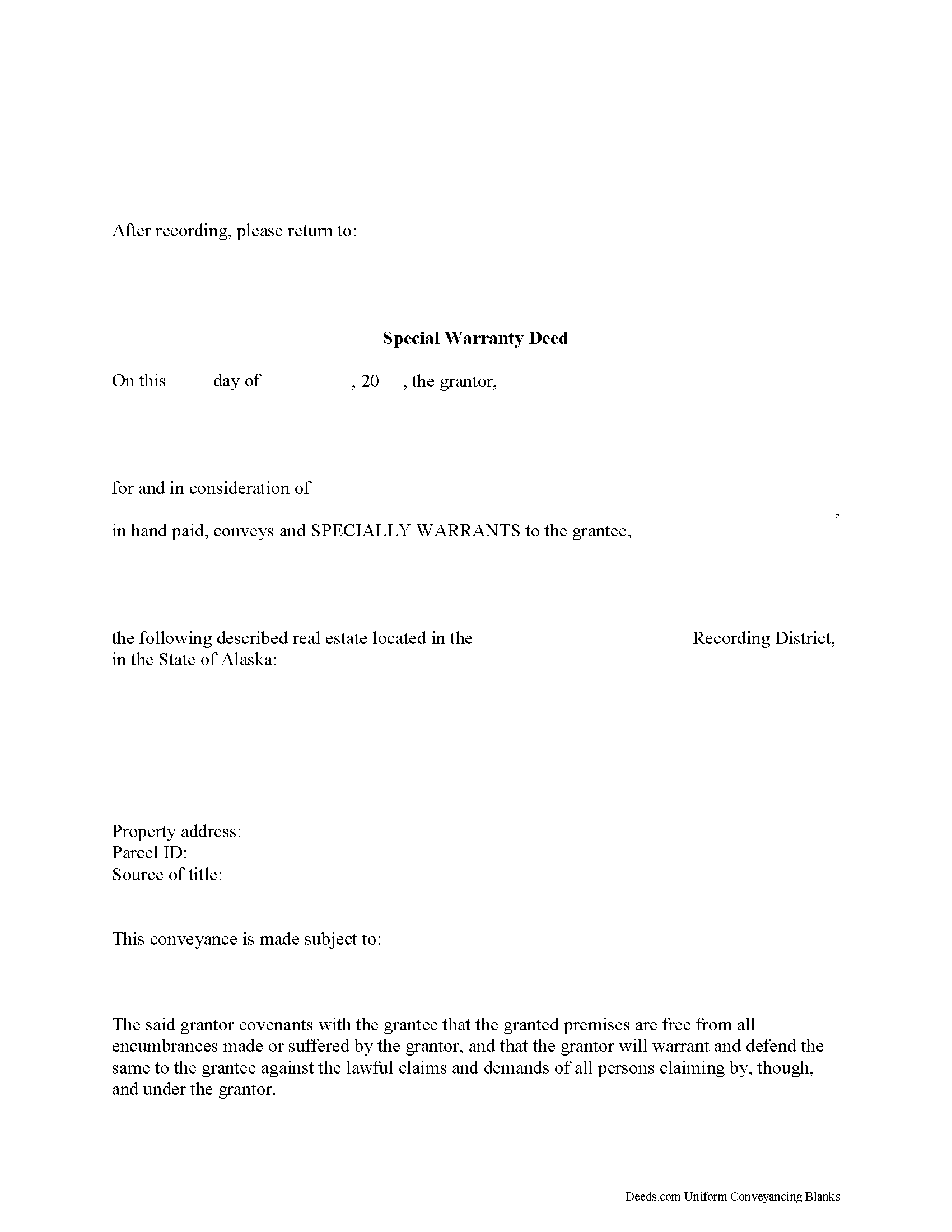
A Special Warranty Deed is similar to a General Warranty Deed however it only contains two basic warranties:
a. That the grantor received title.
b. That the property was not encumbered during the time the grantor held title, except as otherwise noted in the deed.
In a special Warranty Deeds the grantor may include additional warranties but they must be specifically stated in the deed.... More Information about the Alaska Special Warranty Deed
Grant Deed
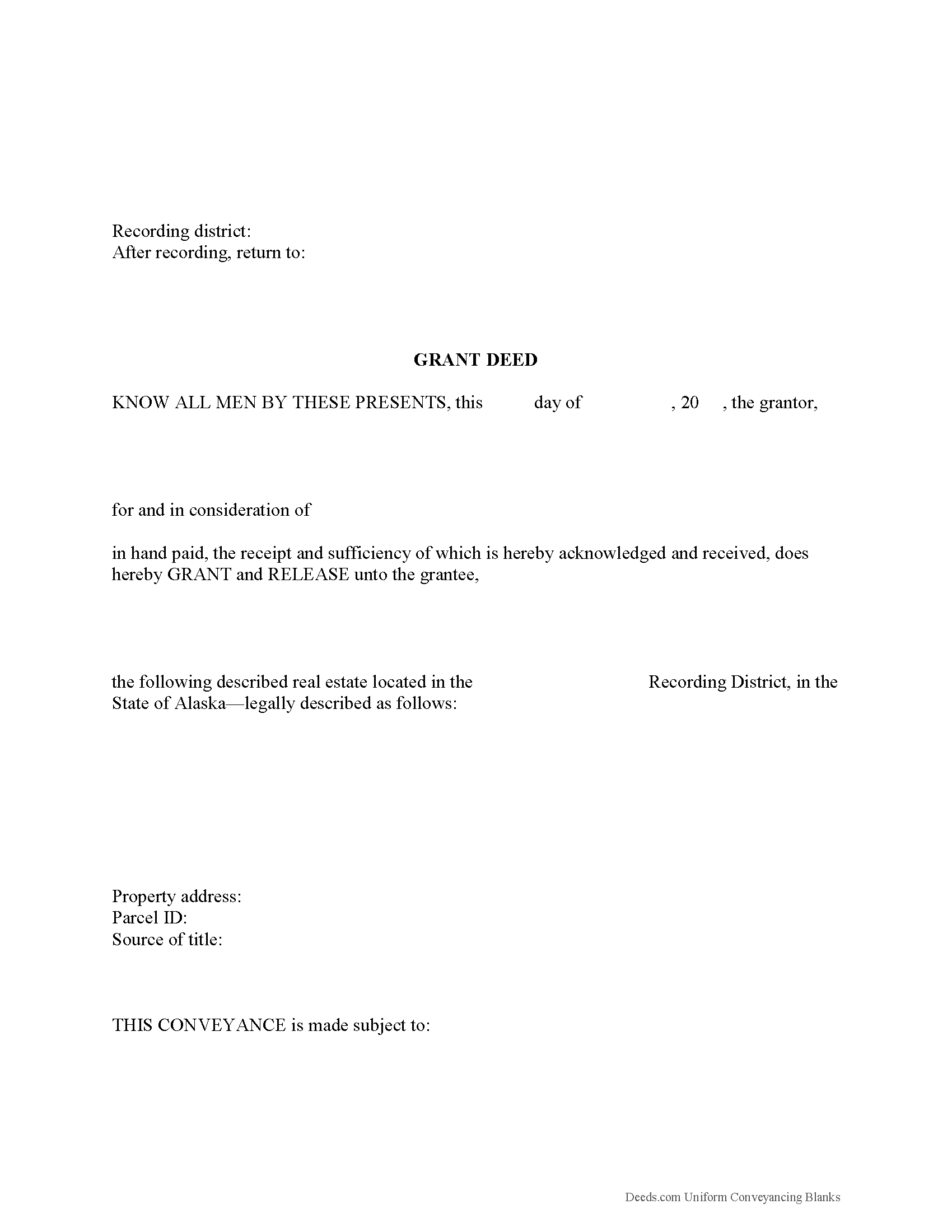
Although not specifically referred to by name in the Alaska Statutes, a grant deed can be used in this state as an instrument of conveyance to transfer property from one person or entity to another person or entity. A grant deed must be signed and sealed by the grantor, and acknowledged or proved, and then recorded in the registry district where the property is located as provided by law.
A grant deed in Alaska warrants that the grantor actually owned the title to transfer. This type of deed also includes a guarantee that the grantor has not sold the property to anyone else, and that the property is not under any liens or restrictions that have not already been disclosed to the buyer, which in turn means that there are no legal claims to the property by third parties.
A grant deed for real property in Alaska needs to be recorded in order to provide constructive notice of its contents to subsequent purchasers and holders of a security interest in the same property or portion of it (40.17.080). A grant deed in Alaska is void as against a subsequent purchaser in good faith and for a valuable consideration of the same real property or part thereof whose conveyance is first duly... More Information about the Alaska Grant Deed
Interspousal Transfer Grant Deed
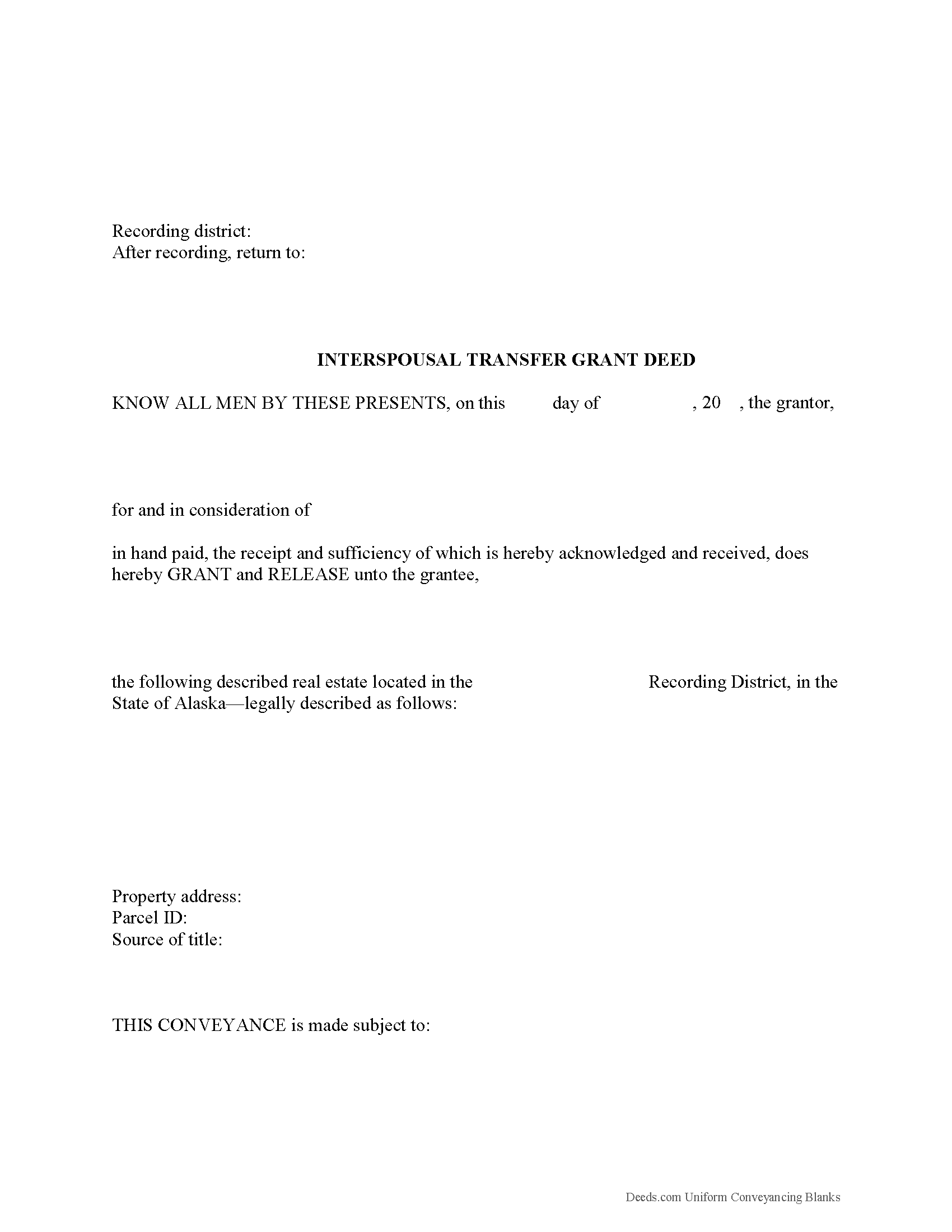
An interspousal transfer grant deed is a legal document used by a married couple to voluntarily transfer title from one spouse to another. This type of deed can be used in situations where both spouses hold title to real estate and one spouse transfers interest in the property to the other. It can also be used when one spouse holds title to real estate in sole ownership and voluntarily transfers the interest in the property to his or her spouse [1]. A grant deed guarantees that the grantor (seller) has a present interest in the property, and provides evidence of a change of title to the grantee (buyer). It also guarantees that the property is not encumbered by any undisclosed liens or restrictions, which means that there are no legal claims to the title by third parties.
This kind of deed is most commonly used during a divorce, where one spouse is awarded sole ownership of the family home. In divorces, this type of deed can be contractual and made part of the settlement. In some cases, the deed is simply a change in legal title. This often occurs when a couple is interested in refinancing their home, and one spouse has poor credit. Sometimes, lenders will ask one spouse to file ... More Information about the Alaska Interspousal Transfer Grant Deed
Correction Deed
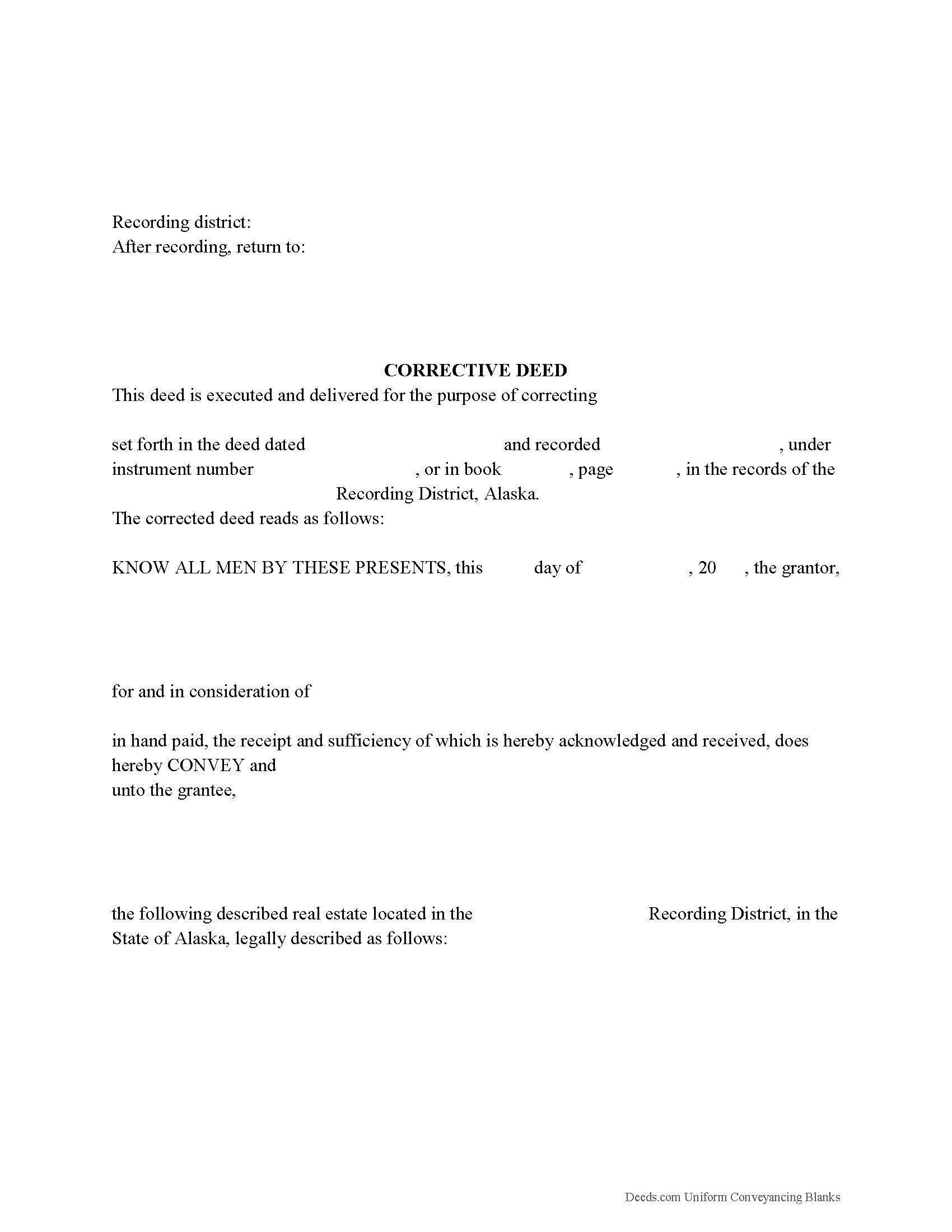
What happens when there is an error in your deed? What can you do to fix it? One option may be filing a corrective deed.
A corrective deed is an instrument used to correct a small error in a deed that has been recorded at an earlier date. Corrections can only be made to non-material errors, causing no actual change in the substance of the deed. Common mistakes include typographical errors, accidentally omitted suffixes or middle initials, misspelled street names, etc.
Major, or material, changes to the substance of the deed have a legal effect in how property is titled, and therefore require a new deed. Adding or removing a grantee, for example, or making significant changes to the legal description, may all require a new deed of conveyance. When in doubt about the gravity of an error and whether a correction deed is the appropriate vehicle to address it, consult with a lawyer.
On the corrective deed, give the recording information from the previously filed document, then identify which section contains the error. Provide the correct details in the body of the deed. The corrective deed states the nature of the error and recites the date and recording information of the e... More Information about the Alaska Correction Deed
Easement Deed
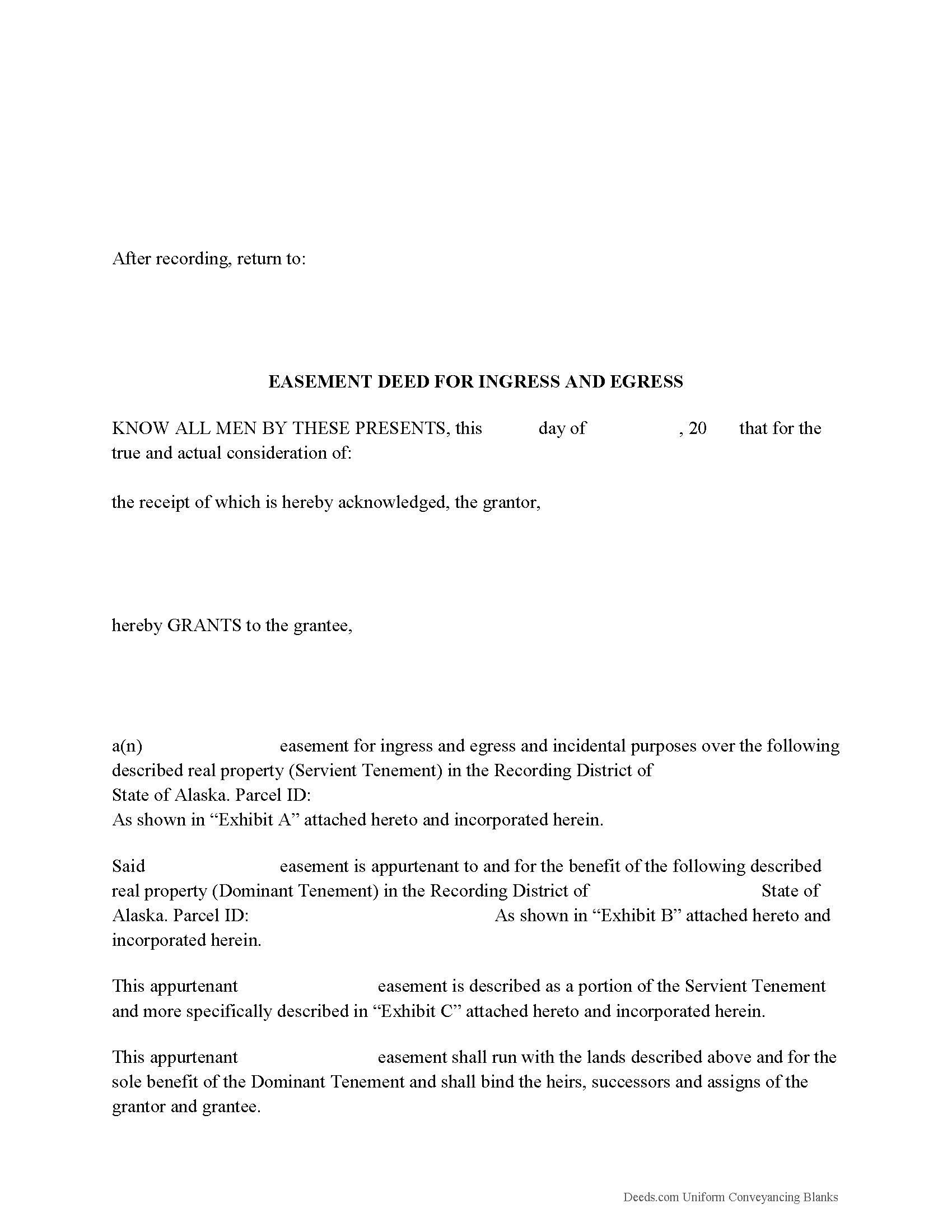
Easement deeds give one person the right to use another party's property without actually possessing it. An easement is a real property interest, but is separate from the owner's legal title of the underlying land. An easement deed in Alaska is subject to the same recording requirements as other conveyances of real property.
A conservation easement in this state can be created, recorded, assigned, released, modified, terminated, or otherwise altered or affected in the same manner as other easements (34.17.010). A conservation easement in Alaska is defined as a non-possessory interest of a holder in real property imposing limitations or affirmative obligations to retain or protect natural, scenic, or open-space values of real property; ensure its availability for agricultural, forest, recreational, or open space use; protect natural resources; maintain or enhance air or water quality; or preserve the historical, architectural, archaeological, or cultural aspect of real property. The holder of a conservation easement can be a governmental body empowered to hold an interest in real property under the laws of Alaska or of the United States; or a non-profit organization empowered ... More Information about the Alaska Easement Deed
Termination, Cancellation of Easement / Right of Way
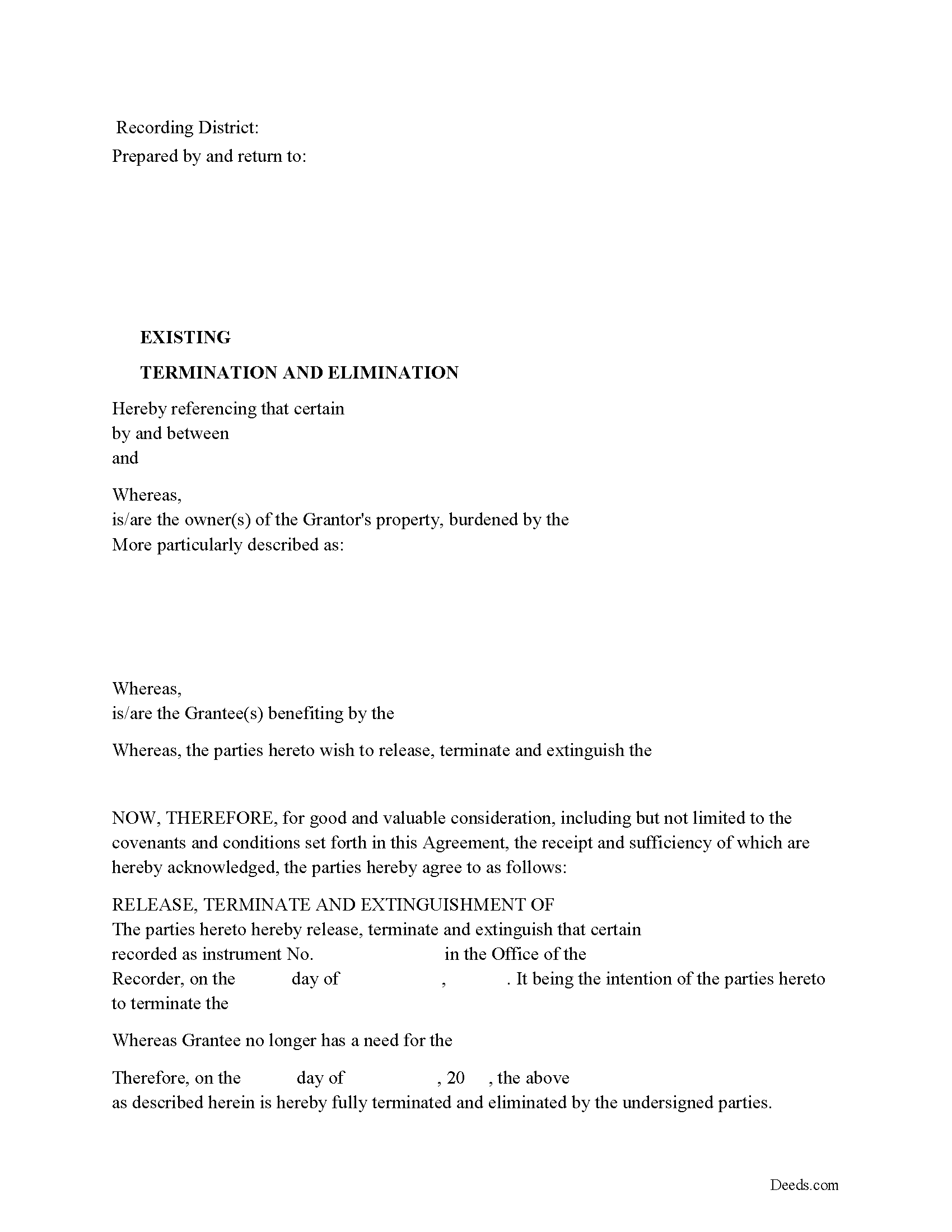
Use this form to release, terminate, extinguish a previously recorded document that involves access to and from a property.
Documents such as:
1. Easement Deeds or Agreements (An easement is a non-possessory interest in land, granting the right to use someone else's property for a specific purpose, like a driveway or utility line)
2. Access Roads
3. Right of Ways
4. Utility Easements (Power, Gas, Water, Sewer, Etc.)
5. Drainage Easements
This document allows the owner of the land, burdened by the access and the party that benefits from the access, to sign an agreement releasing the property from such access, ... More Information about the Alaska Termination, Cancellation of Easement / Right of Way
Transfer on Death Deed
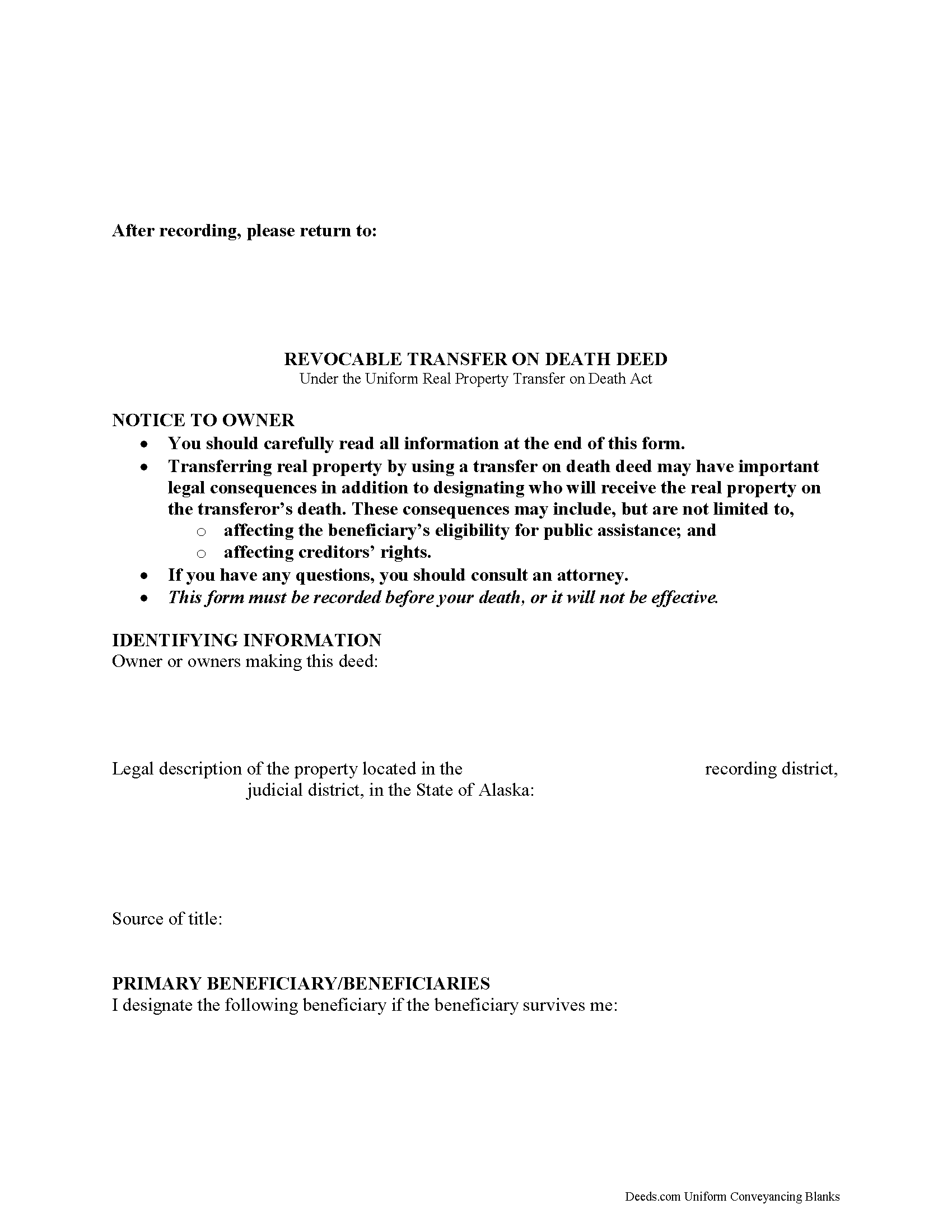
Real property owners in Alaska have an estate planning option: the transfer on death deed (TODD). Find the full text in AS 13.48.
This statute is based on the Uniform Real Property Transfer on Death Act (URPTODA). By adopting the provisions of the URPTODA, Alaska joins with an increasing number of states using this law to help real estate owners manage the distribution of what is often their most significant asset -- their real estate -- by executing and recording a transfer on death deed.
Transfer on death deeds are nontestamentary, which means ownership of the property passes to the beneficiary without including it in a will or a need for probate (AS 13.48.030). Still, best practices dictate that landholders should take care to ensure that their wills and TODDs contain the same directions.
Alaska's version of the URPTODA sets out the specific requirements for lawful transfer on death deeds:
- The capacity required to make or revoke a transfer on death deed is the same as the capacity required to make a will (AS 13.48.040).
- It must contain the essential elements and formalities of a properly recordable inter vivos deed, such as warranty or quitclaim deed (AS 13.48... More Information about the Alaska Transfer on Death Deed
Transfer on Death Revocation
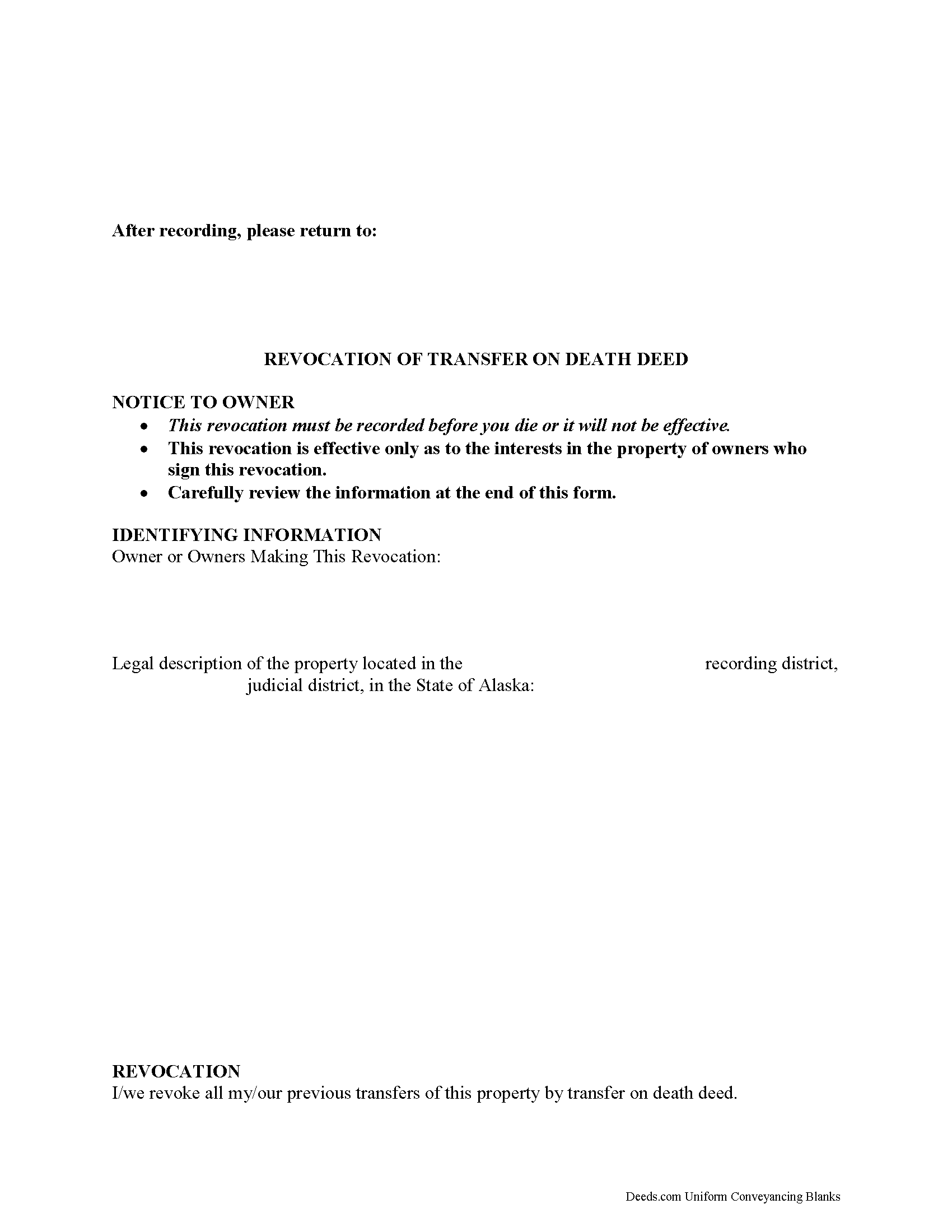
Revoking Transfer on Death Deeds in Alaska
Effective July 21, 2014, owners of real estate in Alaska can take advantage of a useful estate planning tool: the transfer on death deed (TODD). Find the full text of this new law at AS 13.48.
This statute is based on the Uniform Real Property Transfer on Death Act (URPTODA). By adopting the provisions of the URPTODA, Alaska joins with an increasing number of states using this law to help land owners manage the distribution of what is often their most significant asset -- their real estate -- by executing and recording a transfer on death deed.
The named beneficiary gains no present rights to the property, only a potential future interest. Instead, the transferors retain absolute control during their lives. This includes the freedom to sell or transfer it to someone else, and to modify or revoke the intended transfer on death (AS 13.48.080). These details, along with the fact that TODDs only convey the property rights remaining, if any, at the owner's death, explain why they do not require notice or consideration (AS 13.48.060).
Geared to life's unpredictability, the law also includes a mechanism to modify or revoke the previo... More Information about the Alaska Transfer on Death Revocation
Personal Representative Deed
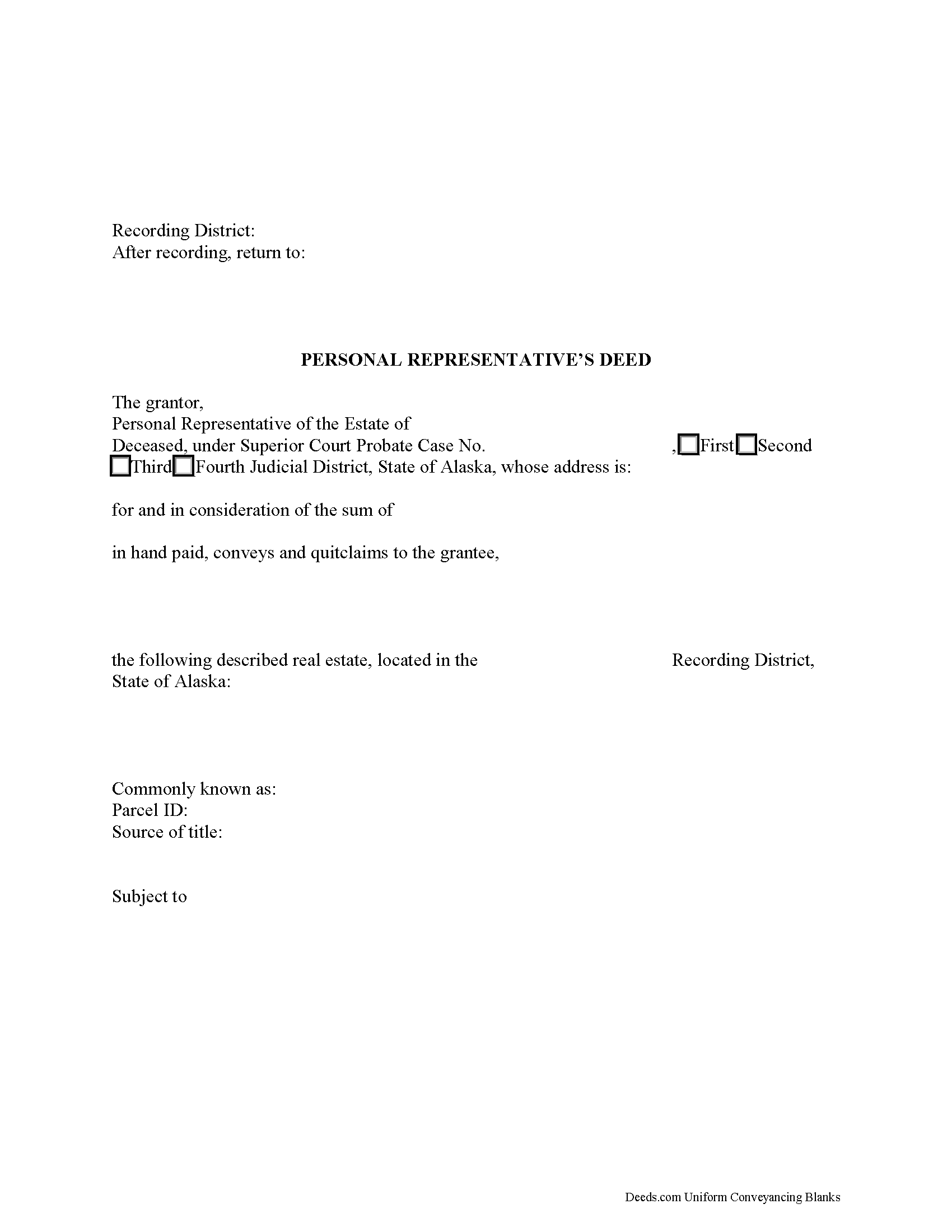
Personal Representatives Deeds in Alaska are governed by the Uniform Probate Code, found at sections 13.06 - 13.36 of the Alaska Statutes.
Use a personal representative's deed to devise or sell a decedent's real property in Alaska. The personal representative (PR) accepts a fiduciary duty to settle the decedent's estate according to the terms of the will (if one exists), and the relevant state and local laws. A PR may be designated in a will or appointed by the probate court when administration of the estate is opened.
Unless the title to real property passes automatically or a transfer on death deed is on record, the estate must go through probate. Probate is the court-directed process of transferring a decedent's assets to the person(s) entitled to receive it. (Note: Real property granted by the Secretary of the Interior to Native Alaskans, designated as restricted property, uses a separate procedure administered through the United States Bureau of Indian Affairs.)
Alaska recognizes informal and formal probate processes. Informal probate uses minimal court supervision and is the more common method. Formal probate requires more court supervision, and is an option for com... More Information about the Alaska Personal Representative Deed
Notice of Right to Lien
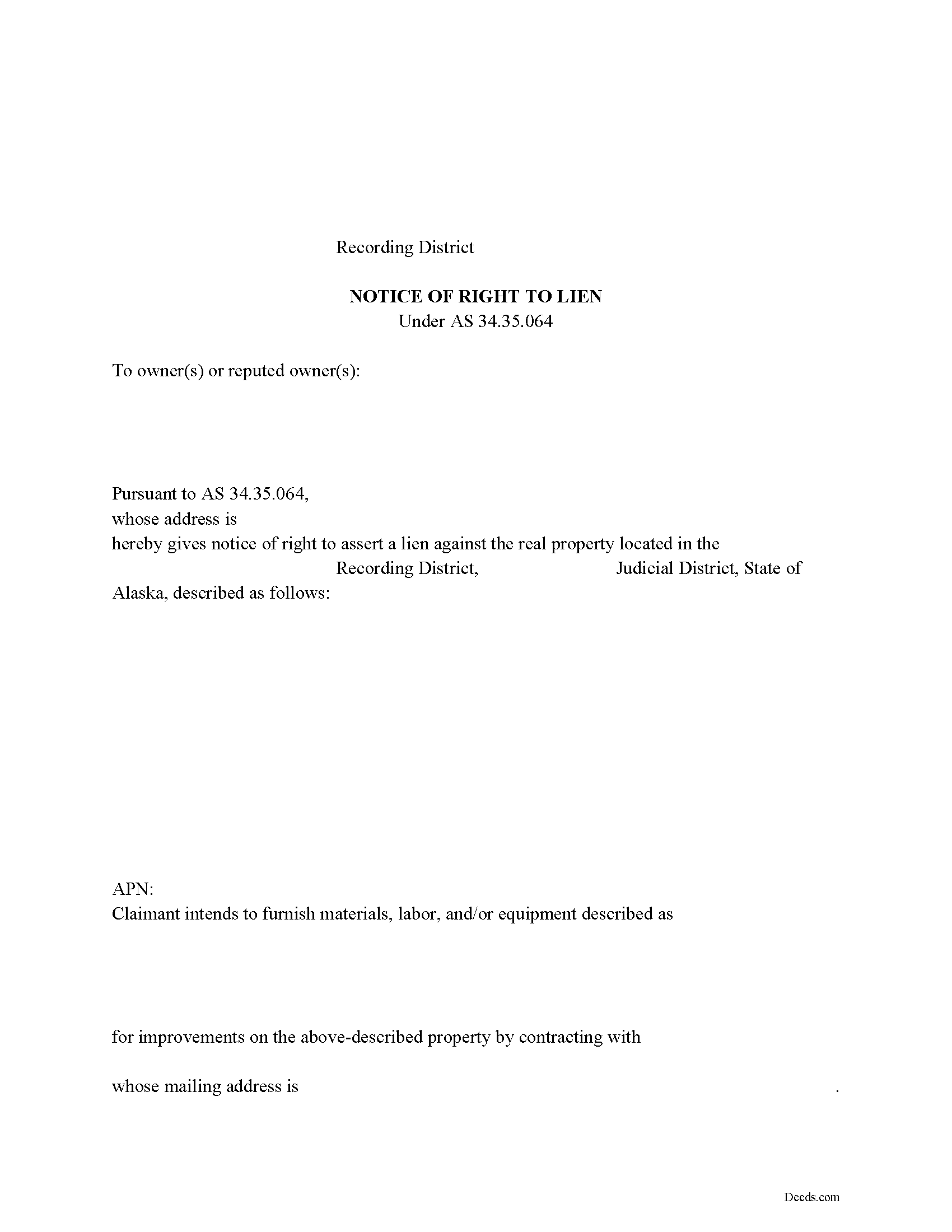
Preliminary notice of the right to file a lien is required in Alaska. A potential claimant has more protection and likelihood of recovery of funds when a notice of right to lien is delivered to requisite parties and recorded in the land records in the recording district where the property the claimant has contracted for improvements is located.
Filing a notice of right to lien gives the claimant 120 days from the completion of a contract or since ceasing to furnish labor, materials, services, or equipment to file a claim of lien (AS 34.35.068).
Potential claimants can record a notice of right to lien under Alaska Statute 34.35.064 before enacting a contract or any time after commencement on the work, though doing so before furnishing the labor, materials, services, or equipment protects the potential claimant for the duration of the job, not just from the date of serving notice. The notice asserts the claimant's right to file a lien, putting the owner on notice. Once a notice of lien is given, the owner has the burden of proof to show that he or she did not know of or consent to the labor or furnishing of labor, materials, services, or equipment.
When a potential lien cla... More Information about the Alaska Notice of Right to Lien
Notice of Completion
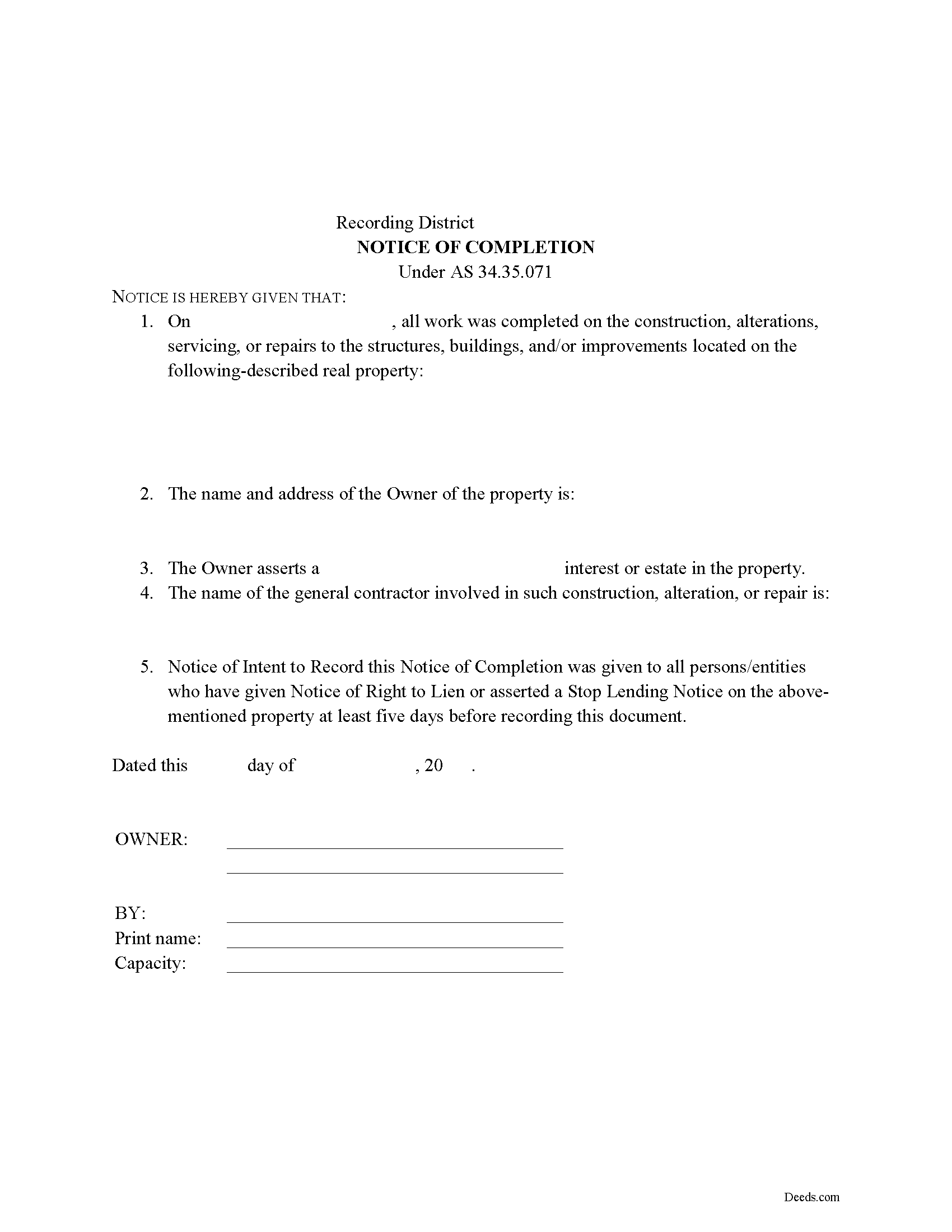
What happens after a contractor notifies the property owner of their right to file a lien? Generally, upon the project's conclusion, the owner responds by filing a notice of completion with the local recording office.
A notice of completion under Alaska Statute 34.35.071 announces the date of completion of a project under contract. The title holder records the notice in the office of the recorder in the recording district where the affected property is located, but only after the completion of the project. The notice is ineffective if recorded before completion (AS 34.35.071(d)).
A recorded notice of completion initiates the period in which a potential claimant may file a claim of lien. The total time a potential claimant has for filing a lien depends on whether the claimant has given notice of right to lien and whether the owner has given proper notice of his intent to record the notice of completion.
The owner files a notice of completion in the district recorder's office where the property is located, in addition to giving five-days' notice (notice of intent to file) before recording to all claimants who have given a notice of right to lien at least 10 days prior to th... More Information about the Alaska Notice of Completion
Claim of Mechanic Lien
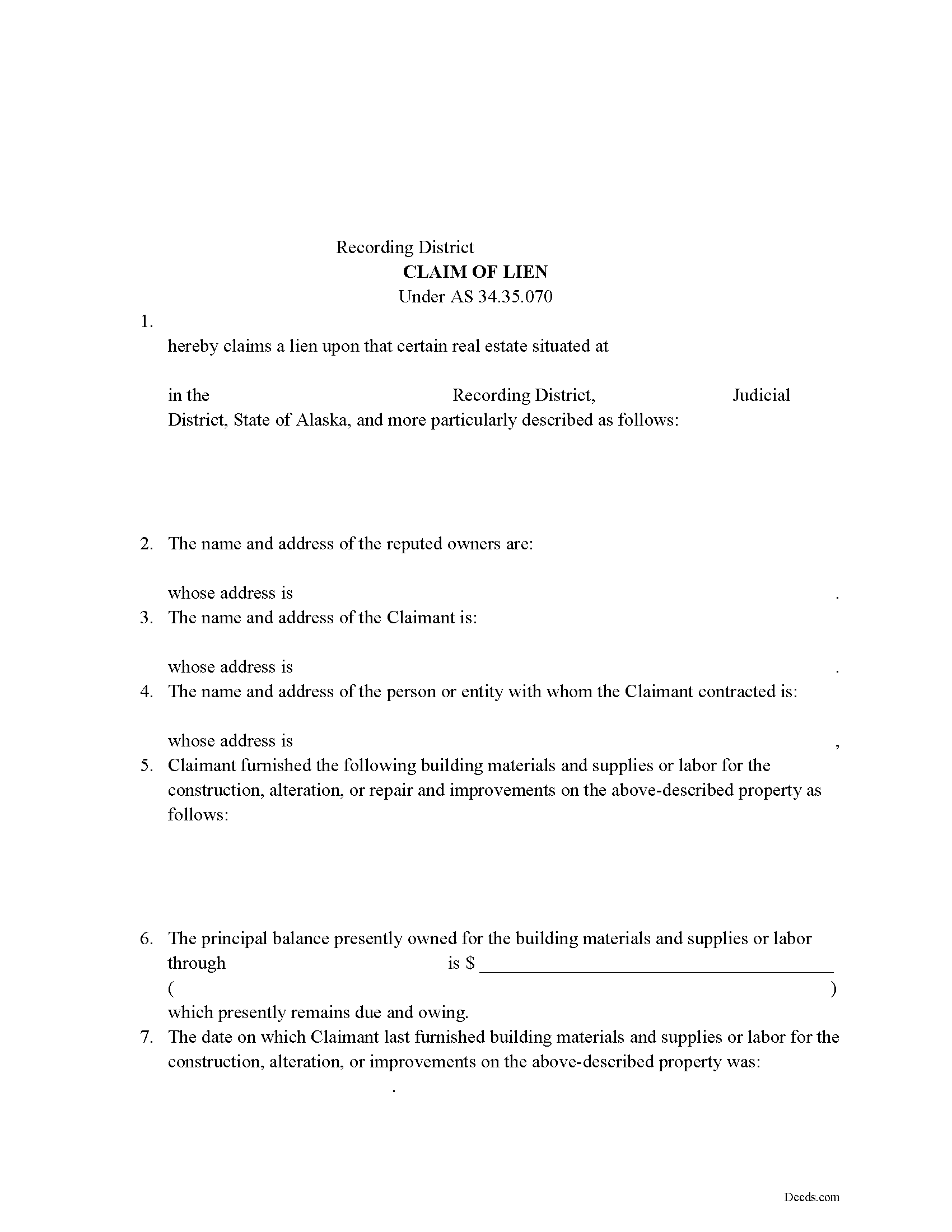
A lien is a security interest used to secure payment of a contract price for labor or materials, services, or equipment furnished in connection with construction, alteration, or repair on real property. It attaches to the property title, and the owner must resolve the lien if he wants to sell or refinance the home.
Under Alaska Statute 34.35.070, a potential claimant can record a claim of lien after entering into a contract for a project. A claimant, as defined by Alaska Statute 34.35.050, is a person who:
-has performed labor for the construction, alteration, or repair of real property;
-is a trustee of an employee benefit trust for the benefit of persons performing the labor;
-furnishes materials or equipment delivered under contract that is/are used in the construction,
alteration, or repair; or
-provides a service under contract such as the preparation of plans, surveys, or architectural or
engineering plans or drawings for the construction, alteration, or repair, whether actually
implemented on that property.
The time limit for recording a claim of lien is established by law at AS 34.35.068 and depends on whether the par... More Information about the Alaska Claim of Mechanic Lien
Waiver of Lien Rights
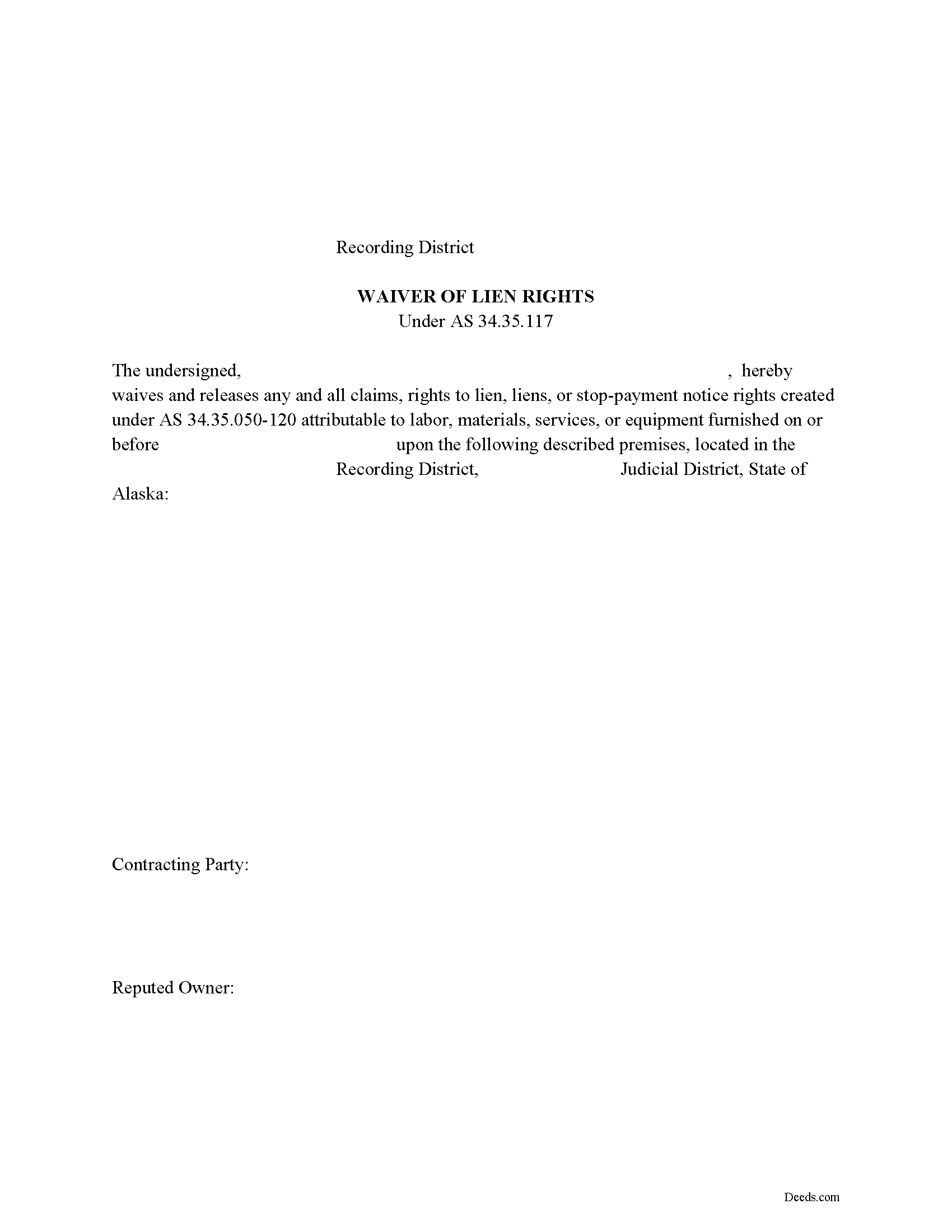
If a potential claimant has filed a notice of right to lien, the claimant may relinquish the right by filing a waiver of lien rights. Once filed, the claimant waives lien rights for labor, materials, services, or equipment furnished up to the date of execution. The waiver also operates as a defense to any lien filed by the claimant (and the claimant would likely be liable for any resulting damages).
When payments are made, lien waivers act as a sort of receipt, stating implicitly that a payment or arrangement for payment has been made by the owner for the potential lien claimant's furnishing labor, materials, services, or equipment for the project at hand. A waiver does not waive future rights to lien for labor, materials, services, or equipment furnished after the date the waiver is signed by the claimant (AS 34.5.117(a)).
A written waiver of lien rights is valid and binding in Alaska when signed by a claimant, and it requires no consideration (AS 34.35.117(a)). Notwithstanding the statutory guidance, best practices dictate that claimants withhold waivers until they receive and confirm payment.
Companies, suppliers, or general contractors (or, persons eligible to file a ... More Information about the Alaska Waiver of Lien Rights
Release of Claim of Lien
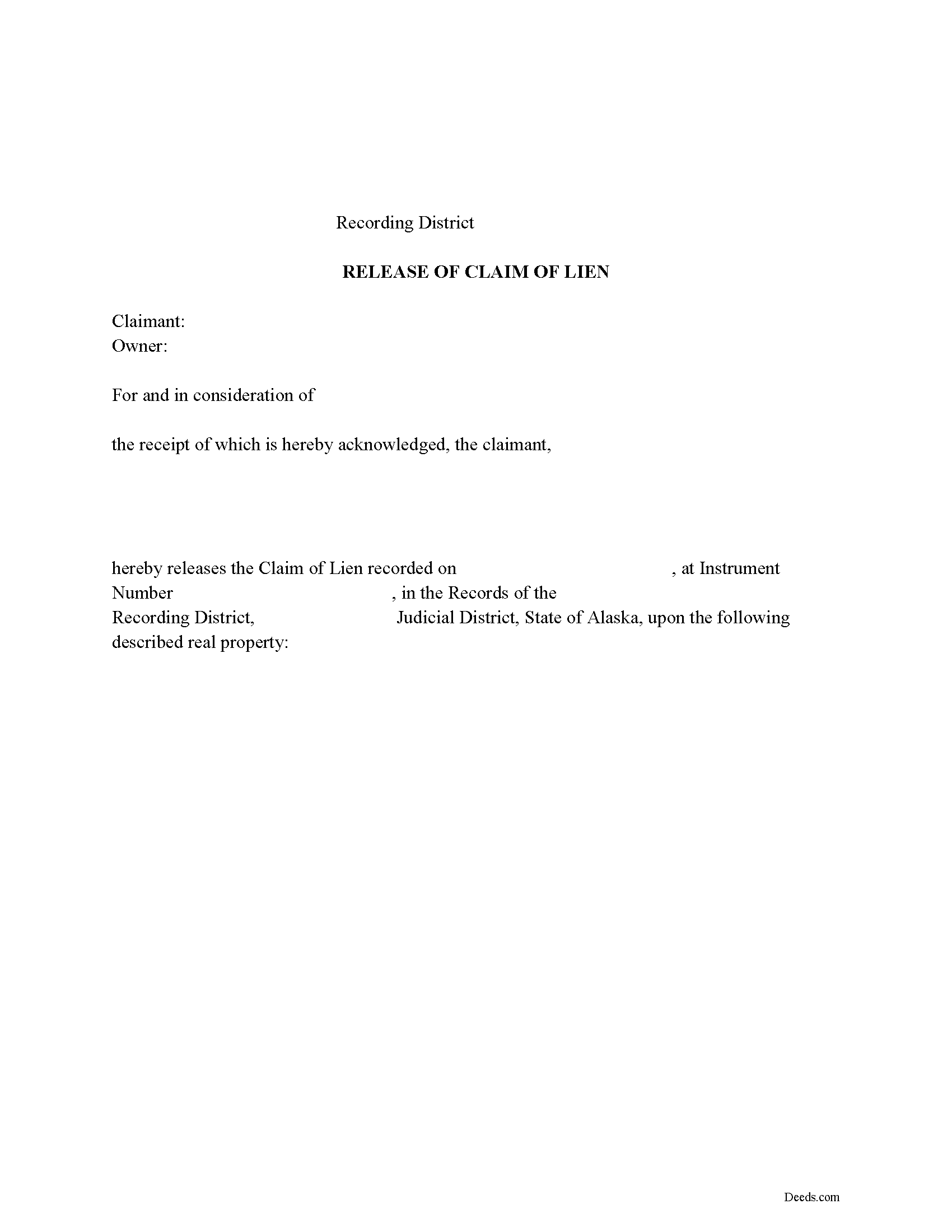
Alaska has no statutory form for a release of lien. Instead, a claim of lien automatically expires 6 months after filed for recording unless judicial action is commenced to enforce it within that time (AS 34.35.080).
When a property owner fulfills the balance owed on a contract subject to a claim of lien, however, the claimant may record a release of lien to evidence that the lien has been resolved before its expiration. By doing so, the claimant clears the lien from the owner's property title, and the title is no longer clouded.
An effective release of claim of lien identifies the claimant as the party releasing the lien and the property's owner who is subject to the lien. In addition, it references the claim of lien by its recording information. The release also functions as a receipt by showing the amount paid by the owner to release the lien. Further, the document includes a complete legal description of the property affected.
Documents relating to real property must meet standards of form and content before recording. A release is not valid unless signed by the claimant and acknowledged in the presence of a notarial official. Record the completed release of claim of ... More Information about the Alaska Release of Claim of Lien
Mineral Deed
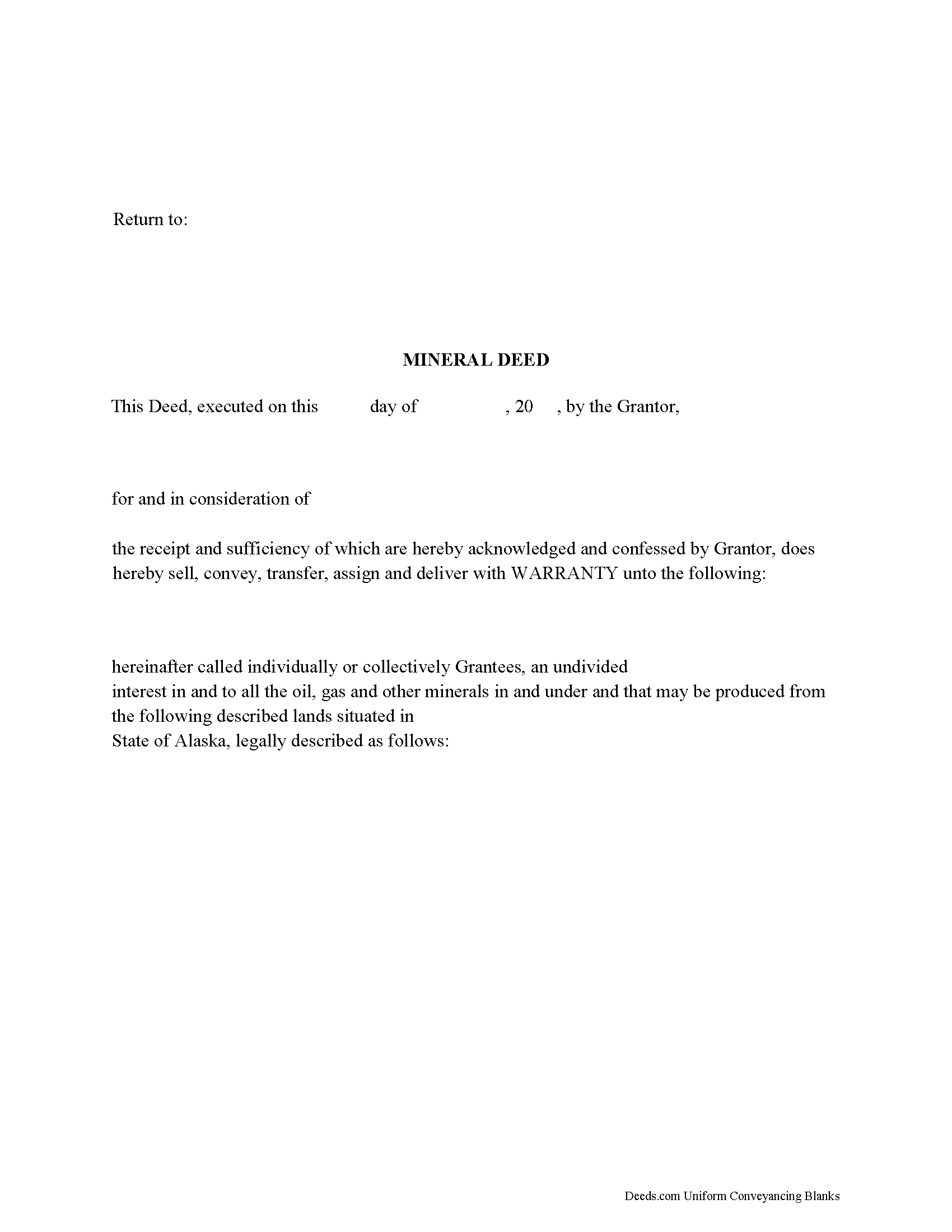
The General Mineral Deed in Alaska transfers oil, gas, and mineral rights from the grantor to the grantee. THIS IS NOT A LEASE. There are no Exceptions or Reservations included.
The transfer includes the oil, gas and other minerals of every kind and nature. It also transfers any and all rights to receive royalties, overriding royalties, net profits interests or other payments out of or with respect to those oil, gas and other minerals. The Grantor can stipulate the percentage of Mineral Rights the Grantee will receive and is made subject to any rights existing under any valid and subsisting oil and gas lease or leases of record.
This general mineral deed gives the grantee the right to access, for the purpose of mining, drilling, exploring, operating and developing said lands for oil, gas, and other minerals, and storing handling, transporting and marketing of such.
In this document the Grantor Warrants and will defend said Title to Grantee. Use of this document has a permanent effect on your rights to the property, if you are not completely sure of what you are executing seek the advice of a legal professional.... More Information about the Alaska Mineral Deed
Mineral Deed with Quitclaim Covenants
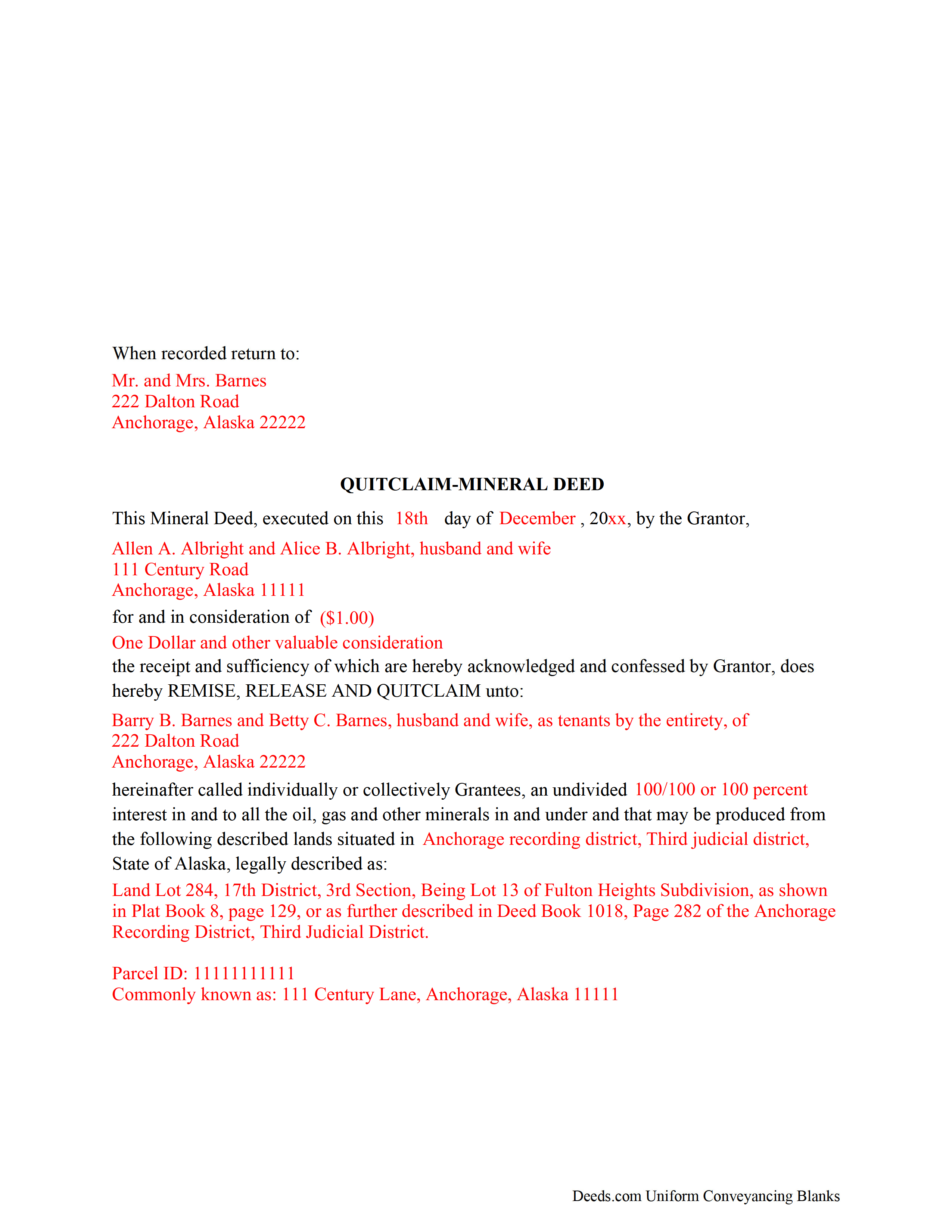
This document is a General Mineral Deed that transfers oil, gas, and mineral rights from the seller (grantor) to the buyer (grantee). It is important to note that this is a transfer of ownership, not a lease.
Rights Included: The deed covers the transfer of ownership of all types of minerals, including oil and gas. There are no exclusions or reservations, meaning the grantee receives all mineral rights encompassed in the deed.
Transfer Details: The grantor specifies the percentage of mineral rights being transferred. The grantee is granted the right to access the land for various activities such as mining, drilling, exploring, and developing the minerals. This also includes the rights to store, transport, and sell these minerals.
No Title Warranty: The grantor transfers the mineral rights without guaranteeing the title's validity. This means the grantee accepts the mineral rights as they are, without any assurance from the grantor that the title is free from legal issues or discrepancies.
Uses: Mineral deeds with quitclaim are often used in situations where the grantor wants to quickly release any interest they might have in mineral rights, such as in settling estates, ... More Information about the Alaska Mineral Deed with Quitclaim Covenants
Disclaimer of Interest
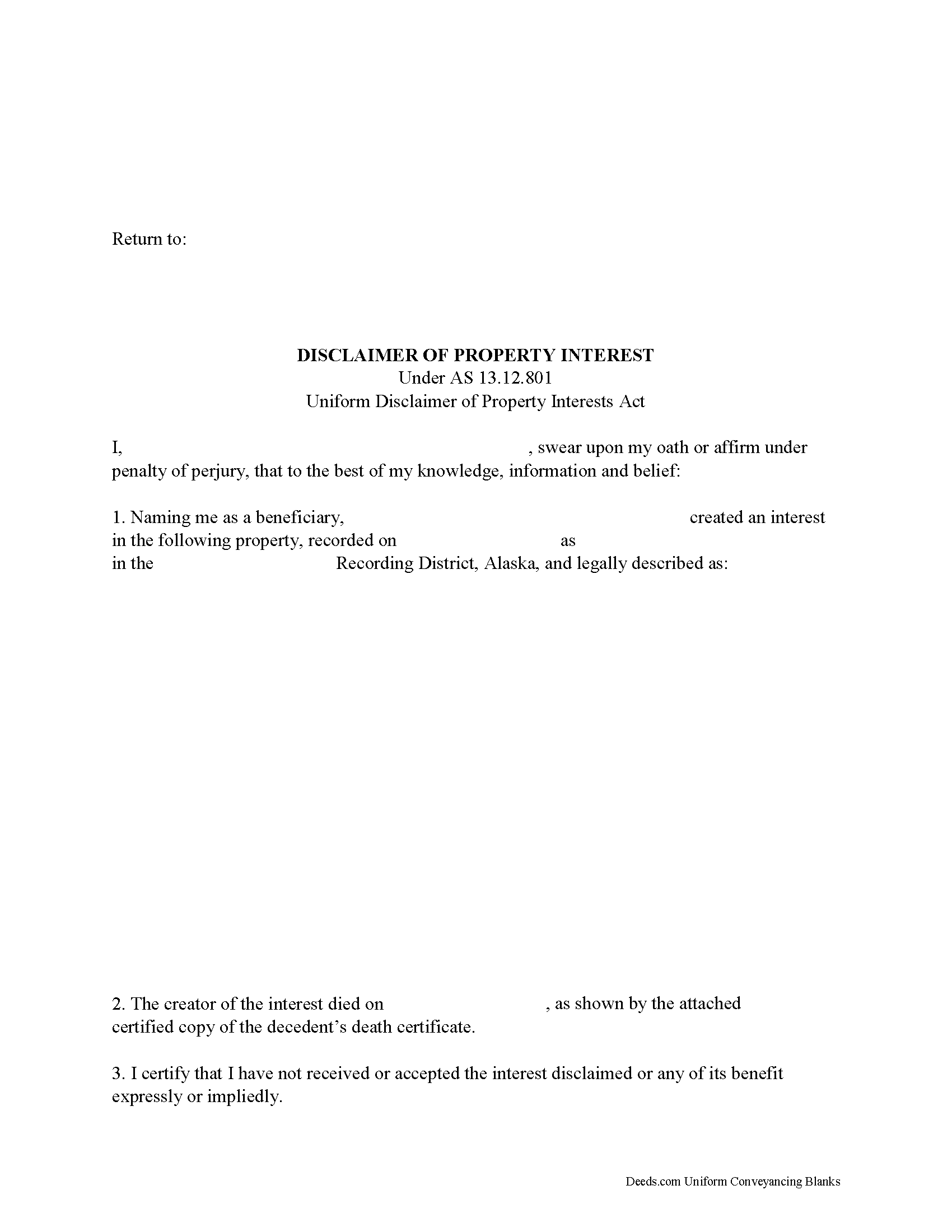
Under the Alaska Statutes, the beneficiary of an interest in property may disclaim the gift, either in part or in full (AS 13.12.801 Uniform Disclaimer of Property Interests Act). Note that the option to disclaim is only available to beneficiaries who have not acted in any way to indicate acceptance or ownership of the interest (AS 13.12.801 (j)).
The document must be in writing and include a description of the interest, a declaration of intent to disclaim all or a defined portion of the interest, and be signed by the disclaimant (AS 13.12.801 (f)).
File the disclaimer within nine months of the transfer (e.g., the death of the creator of the interest) in the court of the judicial district that has jurisdiction over proceedings regarding the administration of the estate of the deceased donor. In addition, deliver a copy, either in person or via registered or certified mail with return receipt, to the personal representative or other fiduciary of the decedent or done (AS 13.12.801 (b)). If real property is involved, record a copy of the document in the office of the recording district in which the property is located in order to avoid any ambiguity regarding the chain of tit... More Information about the Alaska Disclaimer of Interest
Certificate of Trust
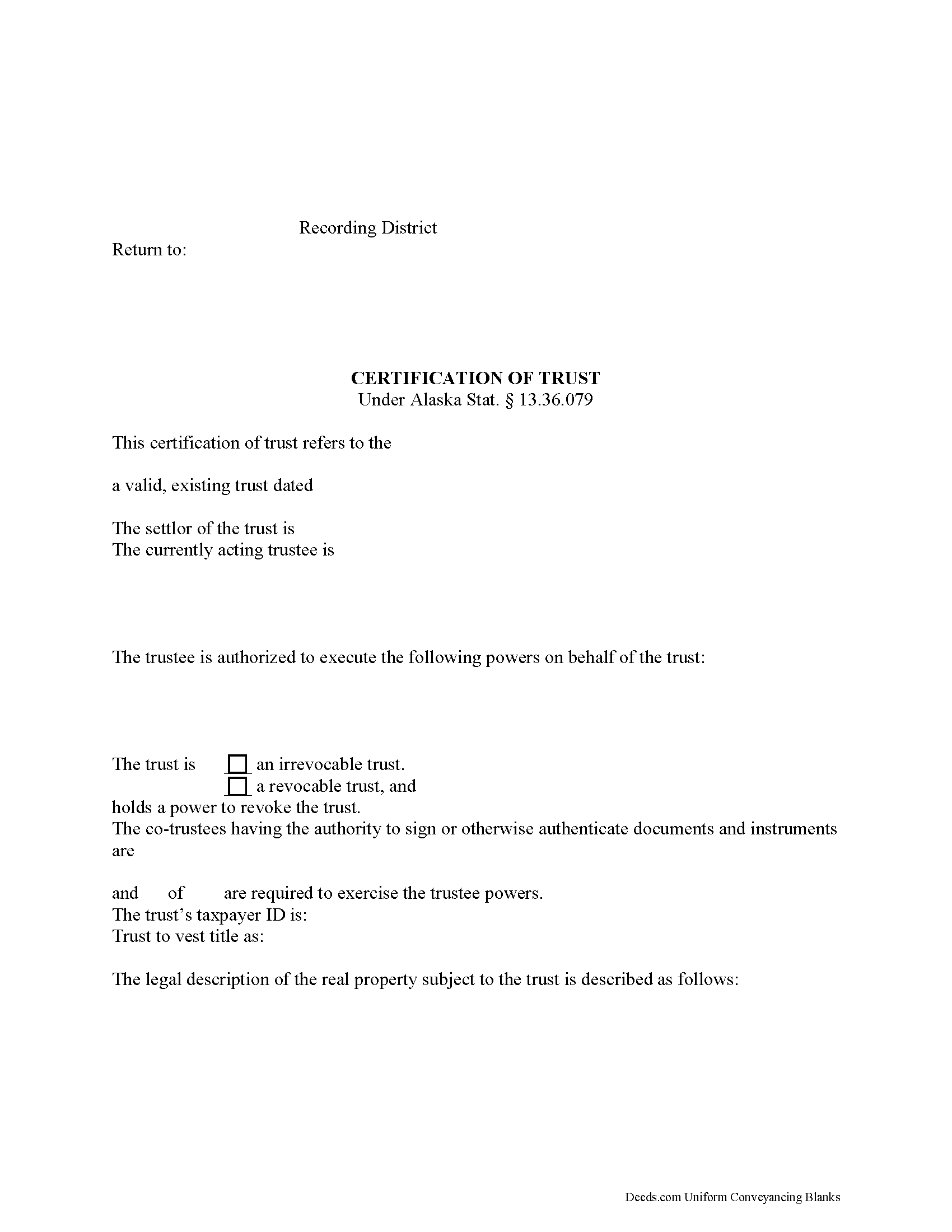
Include this form with real property transactions involving an Alaska trust.
Under AS 13.36.079, a trustee may provide a certification of trust to confirm his/her authority to act on behalf of an established trust agreement. The certification stands in for the full document, thereby preserving the confidentiality of the beneficiaries, as well as other facts unrelated to the immediate transaction.
A lawful certification of trust must include the following information:
The trust exists and the date the trust instrument was executed; the settlor's identity; the currently acting trustee's identity and address; the trustee's powers; whether it is revocable or irrevocable, and identify anyone holding a power to revoke the trust; requirements about co-trustees, if any; the trust's taxpayer identification number, if any; and the manner of taking title to the property of the trust (13.36.079 (a)(1-8)). It may also contain other details as necessary.
The certification of trust includes a statement that the trust has not been revoked, modified, or amended in a manner that would cause the representations contained in the certification of trust to be incorrect (c). The recipient of... More Information about the Alaska Certificate of Trust
Deed of Trust and Promissory Note
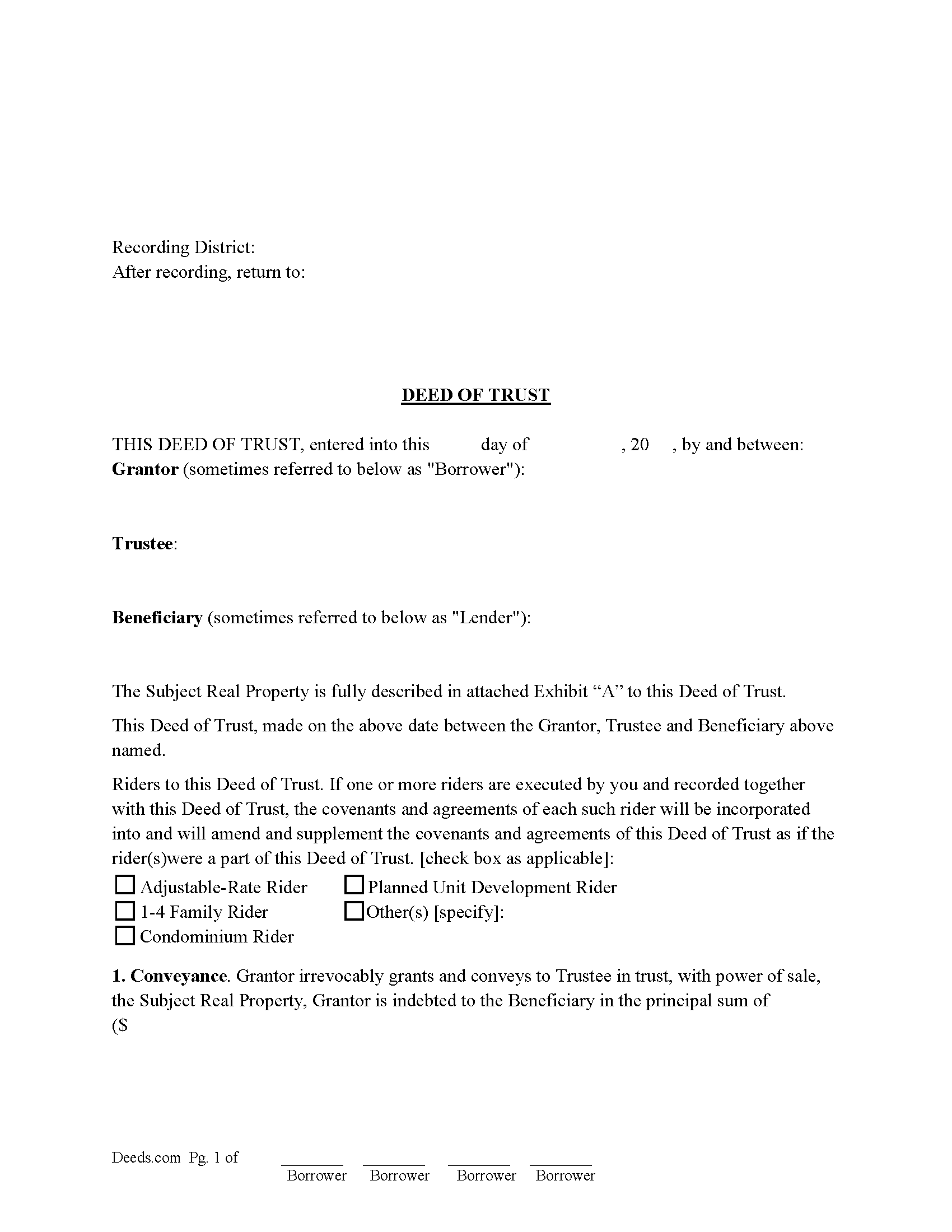
A Deed of Trust is the preferred instrument for financing real property in Alaska. This form contains a power of sale clause, allowing for a non-judicial foreclosure, this can save time and expense for the lender. Use to finance real property; residential, rental, condominiums, vacant land, and planned unit developments.
Alaska Statutes 34.20.110 -- Trust deeds recorded as mortgages For the purposes of record, a deed of trust, given to secure an indebtedness, shall be treated as a mortgage of real estate, and recorded in full in the book provided for mortgages of real property. The person who makes or executes the deed of trust shall be indexed as "mortgagor," and the trustee and the beneficiary or cestui que trust, as the "mortgagees."
A Deed of Trust and Promissory Note that include stringent default terms and conditions can be beneficial to the lender, typical of owner financing, investor financing, etc.
For use in Alaska only.
... More Information about the Alaska Deed of Trust and Promissory Note
Deed of Full Reconveyance
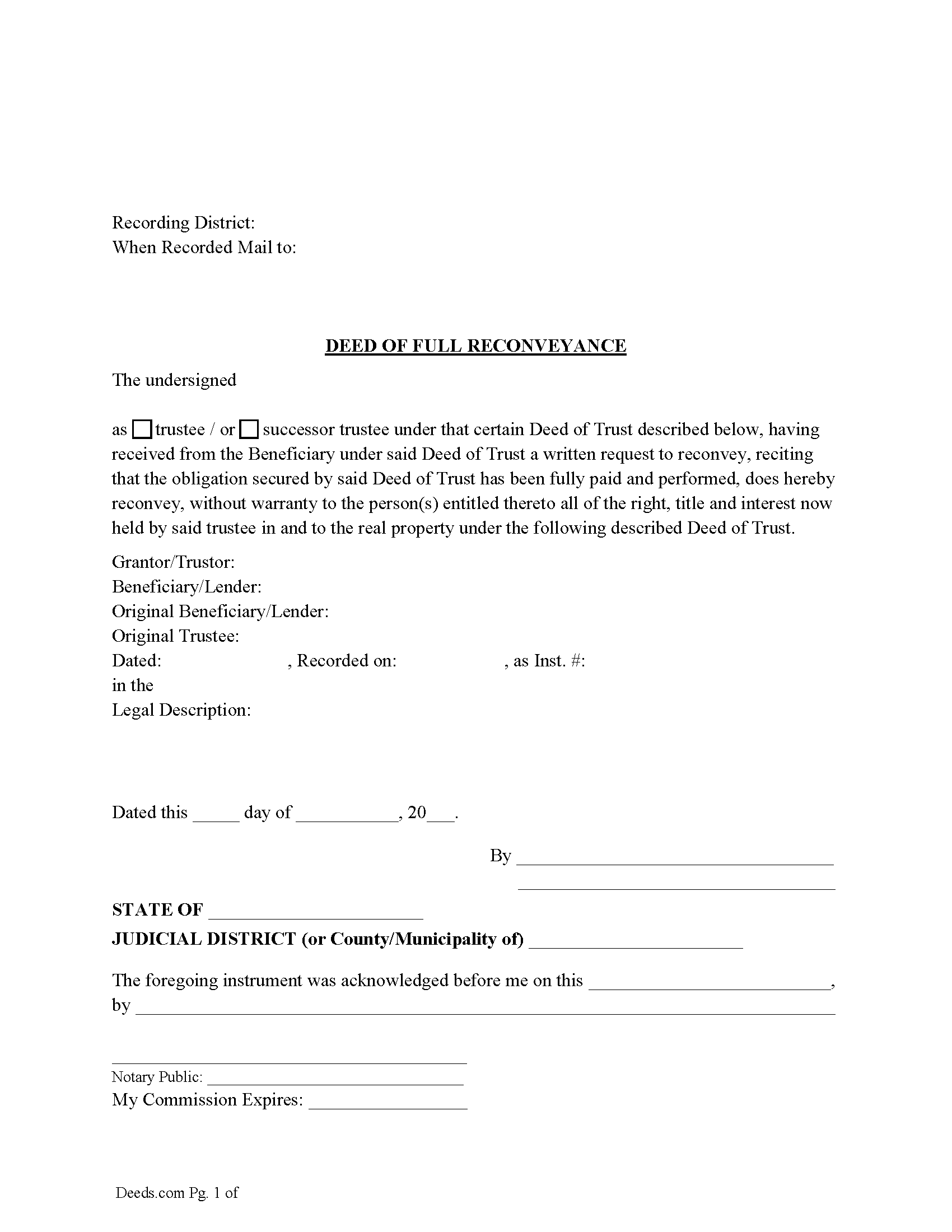
This form is used by the current trustee/successor trustee, when the current beneficiary/lender requests a full reconveyance, upon payment in full of a Deed of Trust. Fully formatted for recording in Alaska's recording and judicial districts.
For use in Alaska only.
... More Information about the Alaska Deed of Full Reconveyance
Substitution of Trustee
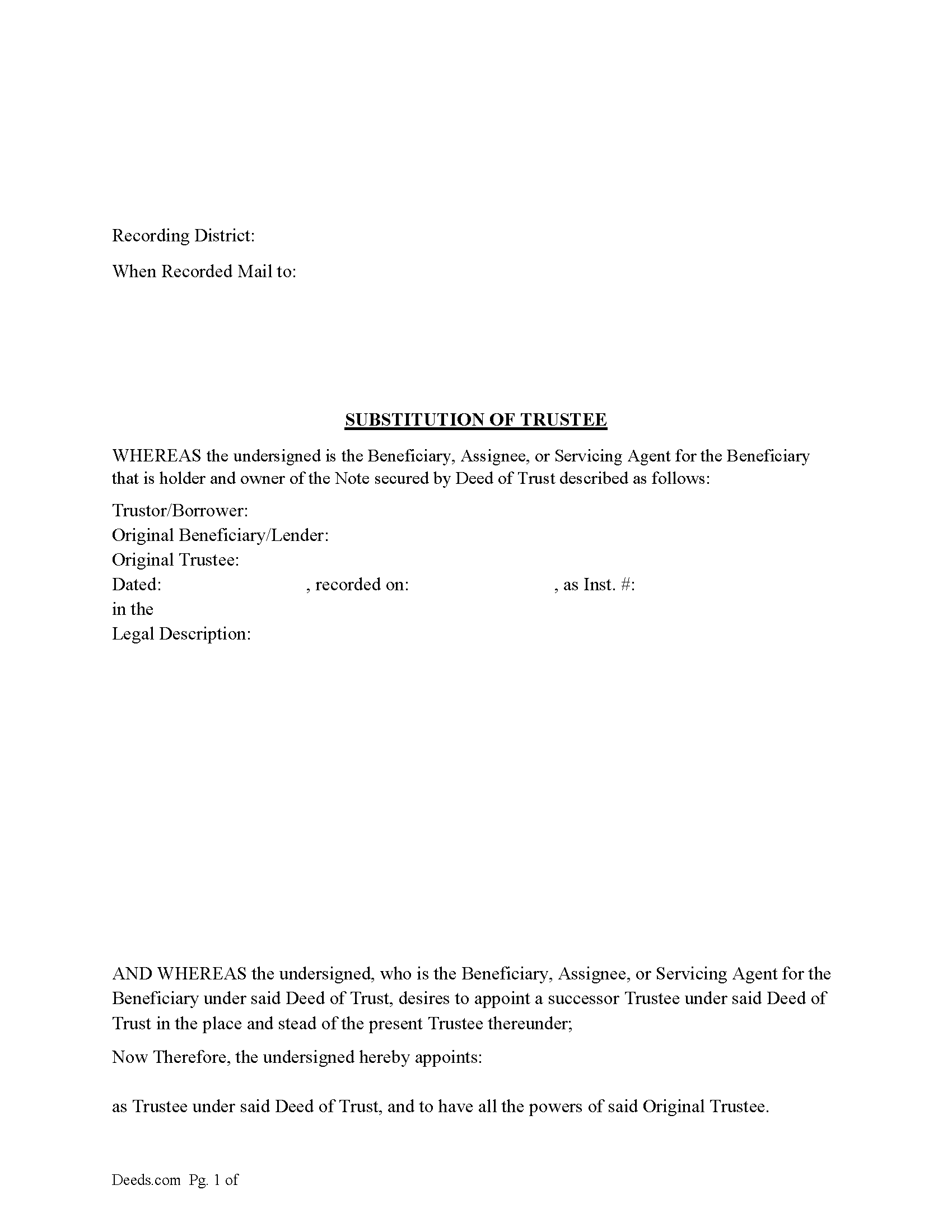
Use this form to substitute a trustee in a previously recorded Deed of Trust, typically executed to perform a foreclosure or when the current trustee can't or won't act.
((b) The substitution must contain
(1) the date of execution of the trust deed;
(2) the names of the trustee, trustor, and beneficiary, and, if the substitution is executed by the attorney for the beneficiary or successor in interest to the beneficiary, the name, address, and Alaska Bar Association identification number of the attorney;
(3) the book and page where the trust deed is recorded or the serial number assigned to the trust deed by the recorder;
(4) the name of the new trustee; and
(5) an acknowledgment signed and acknowledged by the trustee named in the trust deed of a receipt of a copy of the substitution, or an affidavit of service of a copy of it.
(c) From the time the substitution is filed for record, the new trustee succeeds to all the powers, duties, authority, and title of the trustee named in the deed of trust.
(d) When a title insurance company authorized to do business by a certificate of authority granted under AS 21.66 has been purchased by, merged into, or consolidated with, or h... More Information about the Alaska Substitution of Trustee